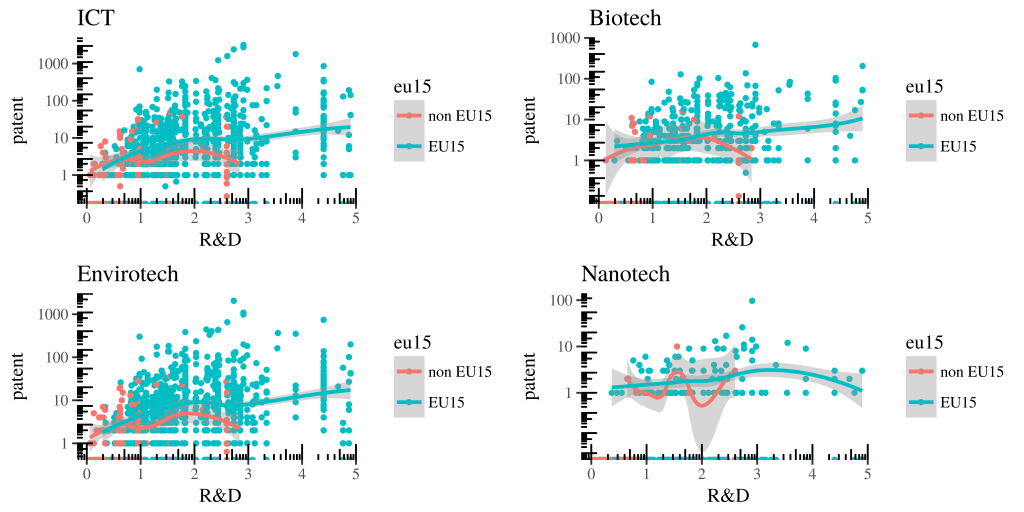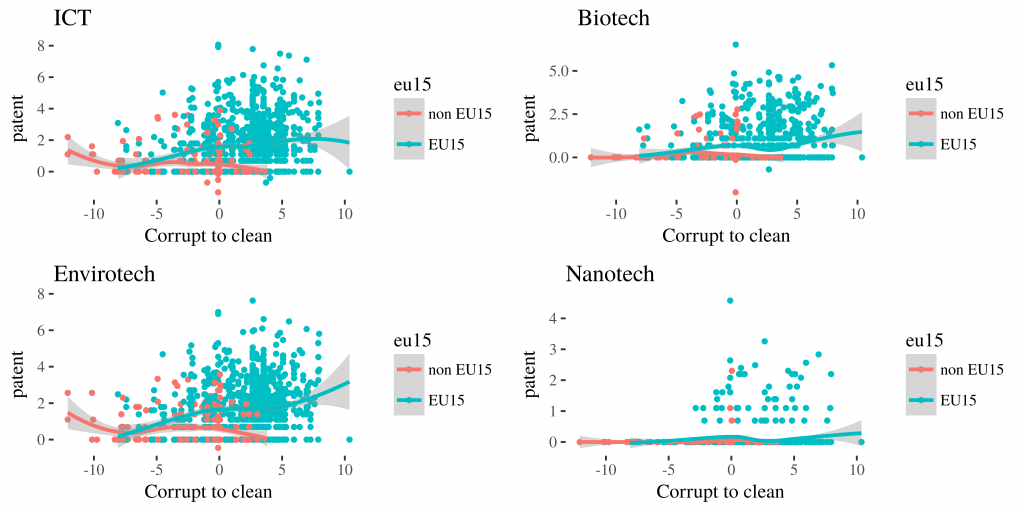Corruption or poor quality governance is inimical to wealth creation. Corruption imposes disincentives to economic activity via two channels. First, a corrupt government is unattractive to people outside its pool of cronies and connections (“crons & cons”), prohibiting outside talents to replenish the governance structure. Second, it imposes disincentives to essentially risky innovative activities (bringing new products or services to the market cf Schumpeter 1942). The risk for the inventor is initially set by an unfair condition put in place to the advantage of the pool of crons and cons (e.g. licences that prioritise them and not awarded on merit). Also inventors are under a shadow of threat: extraction of their innovation rewards as arbitrary rents. Thus would be inventors shrink. A variant of Acemoglu-Robinson hypothesis follows i.e. corruption hinders technological innovation.
The Acemoglu-Robinson hypothesis posits that an extractive institution, where an elitist government puts in place rules and norms to extract rents from economic activities, hinders wealth creation and accumulation. Under such extractive institutions, corruption parasitic on economic activities is normalised, thus diverting resources away from production to greasing the bureaucracy or their crons & cons before economic agents commence productive activities. Downstream, there is an ever present threat that economic returns are extracted as rents by the elite. In contrast, an inclusive institution allows entry to the governing structure by way of contest and merit. And instead of diverting returns from production as rents to the elite, an inclusive institution assigns the returns to economic agents.
In the distinction between who benefits from risky economic activities lie the critical effects of corruption on innovation. Compared to production of goods or services, innovation is a high risk enterprise. In fact, the patent system is created with the aim of ensuring that inventors taking unavoidable high risk are not unduly shrunk by the sheer potential for failure. The patent system (and the government law enforcement) upholds that when the inventors succeed in bringing new goods or technology to the market, the returns for the novel ideas are vested with the inventors alone (a monopoly claim on the novelty). The government’s side of the deal is compensated by the public side where the novelty becomes a public good (anyone with an internet and capacity can freely comprehend and peruse the intricate details of the latest patents awarded to Google or Pfizer from https://worldwide.espacenet.com/). But if there is any chance that the returns are compromised or diverted from the inventor, innovation will be hampered. For instance, if anyone other than the inventors claims priority over the technology. Arbitrary claims are more likely in an extractive institution than in an inclusive one. Moreover, in case of contesting claims by the inventor and other claimants, an institution that upholds the rule of law (a fair game keeper) is desired by all the contestants. An extractive institution compared to an inclusive institution can appear to decree arbitrary decision since it prioritises the elite interest rather than those of the inventors and contestants. Because the extractive versus inclusive institutions are bookends in a continuum, the above hypothesis becomes the further a government is from corruption (cleaner) the more technologically innovative the economy is.
I test the hypothesis using new government quality data from 206 regions in Europe combined with all patents on key technologies from the European patent office (OECD Regpat database, March 2018). Nitotskaya and coauthors (2015) constructed an index of government quality (higher means cleaner) based on responses of 34000 EU citizens when asked about core public services of education, health care and law enforcement. The respondents rated three key dimension for each service: quality, impartiality and the extent of corruption, elicited with 16 questions. The answers were then aggregated to an index of government quality. Next, four key technologies spread over more than one hundred classifications were compiled: information & communication technology (ICT), biotechnology, environmentally sound technology and nanotechnology. The environmental technology classes were identified by the Intergovernmental Panel on Climate Change, while the other three key technologies by the OECD. Last, confounders were also included since technological inventions are driven by research and development investment (R&D), number of graduate workforce and size of market.
The test proceeds by applying non-parametric estimator to the data, showing the underlying relationships in plots of patent against government quality for each technology. In these plots the original 15 EU countries are separated from the later accession countries. As a preliminary, I plot non-parametric estimates of patent against R&D, assessing the ability of the estimator to get at a well known relationship.
Plots of patents in four key technologies vs R&D in European regions 2016
The plots show relationships between patents and R&D in ICT, biotechnology, environmental technology and nanotechnology. Each point is a region with green points marking regions in EU15 countries and orange ones in non-EU15. The plots in green reveal positive and consistent relationships: more R&D means more technological inventions in all technologies. There is a wobble in nanotechnology, though the the relationship remains positive. The non-EU15 regions do not consistently convert more R&D into more technological inventions. The distinct patterns assessed here validate the decision to separate the two types of regions.
Plots of patents in four key technologies vs government quality in European regions 2016
The key results summarised in these plots provide a strong support to the hypothesis especially in EU15 countries. Cleaner government is positively and consistently related to more technological inventions across all key technologies. The strongest relationship appears in environmental technology but the pattern is consistent across the board. Again the patterns were not succesfully replicated in the non-EU15 countries.
The results hold implications for the role of government and innovation. Although government role as rule maker and game keeper has received mention, the main concern lies on where can government directly intervene e.g. by picking (technology ) winners. The results suggest that by shaping risk taking incentives e.g. abrogating the shadow threat of extraction, well run government enhances innovation across a wide range of technologies.
Methodologically, because the measure of government quality here is new, the results serve as an external validity exercise which commend the measure for future research where governance is consequential in economic activity.
Exploiting this measure in studying innovation, this work quantifies the role of government as rule maker and game keeper in encouraging innovations across key technologies. Together with another work which examined how higher government quality improves wealth creation through small and medium enterprises (Nistotskaya et al 2015), this work delineates extra channels through which improvement works. Patents are mostly obtained by large and giant corporations (two were mentioned above). So high government quality positively shapes wealth cretion across the spectrum of enterprises, from small enterprises to giant corporations. More broadly, patents are a contribution to public goods. Anyone with internet and absorptive capacity can exploit them to create even better goods and further services. Inventors in a well governed economy are, as Newton wrote in his letter to Hooke, “standing on the shoulders of giants”. Because high quality governance conditions the creation of high quality public goods.
References
- Acemoglu, Robinson 2012. Why Nations Fail. Crown: New York.
- Lipsey, Carlaw, Bekar 2005. Economic Transformations: General Purpose Technologies and Long Term Economic Growth. Oxford: OUP.
- Nistotskaya, Charron, Lapuente 2015. The wealth of regions: quality of government and SMEs in 172 European regions. Environment and Planning C: Government and Policy. 33 :1125-1155.
- Schumpeter 1942. Capitalism, Socialism and Democracy. New York: Harper



